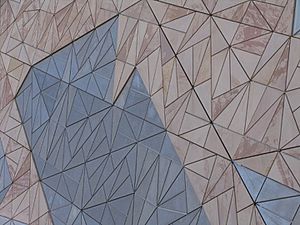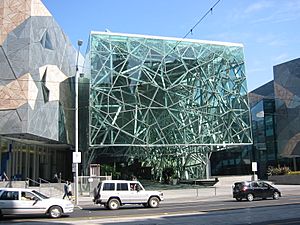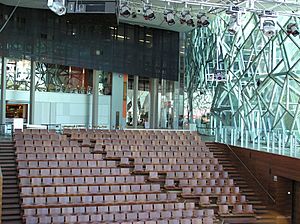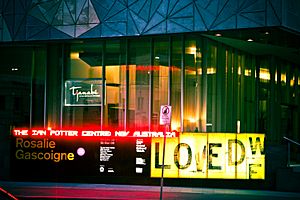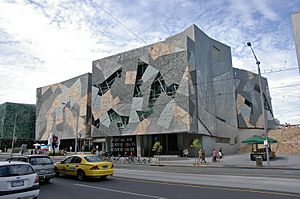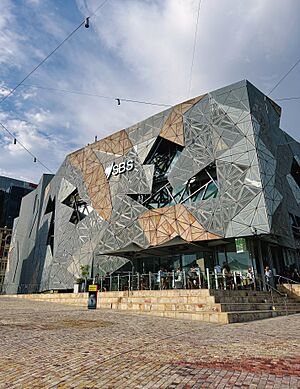Federation Square facts for kids
Quick facts for kids Federation Square |
|
|---|---|
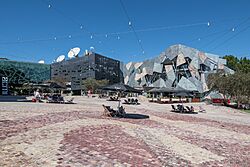
Ground view of Federation Square, showing the common area, and the ACMI, NGV and SBS buildings
|
|
| Type | Public space |
| Location | Melbourne, Victoria, Australia |
| Area | 3.2 ha (7.9 acres) |
| Created | 26 October 2002 |
| Designer | Lab Architecture Studio Bates Smart |
| Operated by | Fed Square Pty Ltd (State Trustees Ltd for State of Victoria) |
| Visitors | 9.7 million per annum |
| Open | All year |
| Public transit access | Flinders Street station Tram routes 1, 3, 5, 6, 16, 64, 67, 72 |
| Official name | Federation Square |
| Type | State Registered Place |
| Criteria | a, d, e, f, g |
| Designated | 12 September 2019 |
| Reference no. | H2390 |
Federation Square, often called Fed Square, is a popular place in Melbourne, Australia. It's a hub for art, culture, and public events. This large area covers about 3.2 hectares (that's like 8 football fields!). It sits right in the middle of the city, near the Yarra River. You'll find cool buildings here, like the Ian Potter Centre and the Australian Centre for the Moving Image (ACMI). There are also cafes, bars, and a big open square where people gather. It's built right over busy train tracks, making it a clever piece of city design.
Contents
History of Federation Square
Why Melbourne Needed a Square
Melbourne's city center was planned a long time ago. But it didn't have a main public square where everyone could meet. People thought this was missing. From the 1920s, there were ideas to build a square over the railway lines. These lines were at the corner of Flinders and Swanston Streets.
In the 1960s, a different "City Square" was built. But it wasn't very popular. Meanwhile, some railway lines were covered by buildings called the "Gas & Fuel Buildings." These buildings had a plaza that wasn't used much. The area near the Yarra River was mostly train yards.
In 1978, the government asked for ideas to make Melbourne famous. One idea was to cover the train yards again.
Choosing the Design
In 1996, the leader of Victoria, Jeff Kennett, announced a big plan. The old Gas & Fuel Buildings would be knocked down. The train yards would be covered. A new complex with art spaces and a public square would be built. It was named Federation Square. The goal was to open it by 2001, to celebrate 100 years since Australia became a nation.
Architects from all over the world sent in their designs. The winning design came from a team called Lab Architecture Studio and Bates Smart. Their plan was very modern and unique. It had buildings with unusual angles and shapes. The square itself was designed like a gentle slope. It had a huge screen for public events. Some people loved the design, but others thought it was too different. There was also a concern that one of the new buildings would block the view of St Paul's Cathedral.
The plans changed a bit over time. The cinema center became ACMI. Offices for the TV channel SBS were added. The art gallery became the National Gallery of Victoria's Australian art section, called the Ian Potter Centre.
Building the Square
Building Federation Square was a huge job. It was expensive to cover the railway lines. The unique design also made construction tricky. The cost ended up being much higher than first thought. The state government paid most of the money.
Federation Square officially opened on October 26, 2002. It quickly became a major meeting place in Melbourne.
Changes and New Ideas
Over the years, Federation Square has seen some updates. In 2006, the area along the Yarra River, called Federation Wharf, was redeveloped. It now has cafes and outdoor spaces.
There have been ideas for the empty train yards to the east. These include new buildings or even another art gallery.
In 2017, there was a plan to build an Apple Store in Federation Square. This caused a lot of debate. Many people felt that a commercial store didn't fit a public cultural space. Groups like Our City Our Square fought against it. Because of this, Federation Square was added to the Victorian Heritage Register in 2019. This protects its special character. Apple then cancelled their plans.
Around the same time, a new entrance for the Melbourne Metro Tunnel train station was planned. This entrance would be at the corner of Federation Square. The old Information Centre building was removed for this project. The new entrance was completed and opened with the new Town Hall station in 2024.
In early 2022, a new group was formed to manage Federation Square. This group also helps connect all the art places in the area. In late 2023, some articles discussed the square's good and bad points. They noted that some shops had closed and that the ground surface could be tricky for walking. They concluded that Fed Square is still improving.
Location and Layout
Federation Square is like a whole city block. It's surrounded by Swanston, Flinders, and Russell Streets, and the Yarra River. The main square is right across from Flinders Street station and St Paul's Cathedral. The way it's designed helps connect the old city center to the Yarra River and a new park called Birrarung Marr.
Design Features
The Main Square
The buildings form a U-shape around the main open square. The eastern side has glass walls, part of The Atrium. While some areas use bluestone, like other Melbourne footpaths, the main square is special. It's paved with 470,000 sandstone blocks from Western Australia. These blocks are a warm, earthy color, reminding people of the Australian outback. The paving is a huge artwork called Nearamnew. It gently rises and falls, with words carved into its surface.
You'll also find some landscaped areas with Eucalyptus trees.
Plaza and Giant Screen
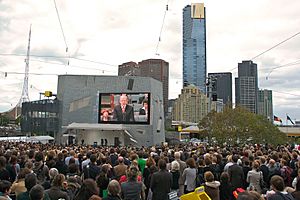
A big part of the plaza is its huge public television screen. This screen shows major sports events every year. It's the biggest broadcasting screen in Australia.
Buildings' Unique Look
The buildings at Federation Square have a unique style. They use angled shapes and lines instead of straight ones. This style is called deconstructivist architecture. The buildings are mostly tall, narrow shapes. They are separated by glass sections, like Melbourne's famous laneways. Tall, thin "shards" also add vertical accents. These shards hold things like the Visitor's Centre or stairs.
The buildings have an outer layer of cladding. This cladding is made of six different materials. These include zinc, glass, and sandstone. They are arranged in a pattern that looks a bit like camouflage.
Some buildings have names. The one along Flinders Street with ACMI and SBS is the Alfred Deakin Building. The building between the plaza and the river is the Birrarung Building. The building with the NGV Australia is the Ian Potter Centre.
Shards
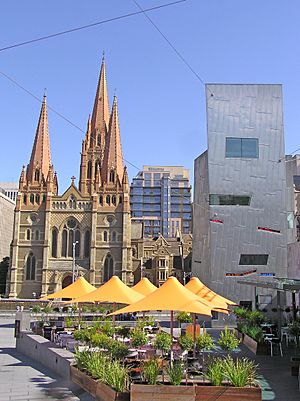
Three tall, angular structures, called shards, frame the square. The eastern and southern shards are covered in metal. The western shard is made of glass.
Laneways and Riverfront
Federation Square has many small laneways. These connect Flinders Street to the Yarra River with stairs. The riverfront area has a walkway with tall trees. The old vaults under Princes Bridge have been turned into Federation Wharf. This area has cafes and places to dock boats.
The Atrium
The "Atrium" is a major indoor public space. It's like a tall laneway, five stories high. It has glass walls and a glass roof. The metal structure and glass patterns match the unique style of the other buildings.
The Labyrinth Cooling System
Underneath the square, above the railway lines, is a clever cooling system. It's called the "labyrinth." This concrete structure has 1.2 kilometers of interlocking walls. It covers a large area.
In summer, cool air is pumped into the labyrinth at night. This cools the concrete. During the day, this cool air is pumped into the Atrium. This can make the Atrium up to 12°C cooler than outside. It uses much less energy than regular air conditioning. In winter, the system works in reverse. It stores warm daytime air to heat the Atrium later.
Flagpoles
Federation Square has several flagpoles. Three of them always fly the Australian, Aboriginal, and Torres Strait Islander flags. A fourth flagpole sometimes flies the flag of another country. This happens to celebrate that country's national holiday.
Many countries' flags have been raised here, including:
 Albania
Albania Argentina
Argentina Azerbaijan
Azerbaijan Bangladesh
Bangladesh Belgium
Belgium Bhutan
Bhutan Bosnia and Herzegovina
Bosnia and Herzegovina Botswana
Botswana Canada
Canada Chile
Chile Croatia
Croatia Cyprus
Cyprus Denmark
Denmark Djibouti
Djibouti Ecuador
Ecuador El Salvador
El Salvador Eritrea
Eritrea Finland
Finland France
France Germany
Germany Greece
Greece Haiti
Haiti Hungary
Hungary India
India Indonesia
Indonesia Iran
Iran Israel
Israel Italy
Italy Japan
Japan Kosovo
Kosovo Lithuania
Lithuania Malawi
Malawi Malaysia
Malaysia Maldives
Maldives Malta
Malta Mauritius
Mauritius Mexico
Mexico Morocco
Morocco Nepal
Nepal Netherlands
Netherlands North Macedonia
North Macedonia Norway
Norway Pakistan
Pakistan Palestine
Palestine Peru
Peru Philippines
Philippines Poland
Poland Portugal
Portugal Rwanda
Rwanda Singapore
Singapore Slovenia
Slovenia Somalia
Somalia South Africa
South Africa Spain
Spain Sri Lanka
Sri Lanka Switzerland
Switzerland Turkey
Turkey Ukraine
Ukraine United Kingdom
United Kingdom United States of America
United States of America Venezuela
Venezuela
Things to Do and See
Federation Square has many shops, cafes, and restaurants. It also has important cultural places:
Melbourne Visitor Centre
The Melbourne Visitor Centre helps tourists find their way around the city. It used to be at Federation Square. But in 2018, it was moved back to the Melbourne Town Hall. This change happened to make space for the new Metro Tunnel station entrance.
The Edge Theatre
The Edge is a theatre with 450 seats. It offers great views of the Yarra River. It was known as "The BMW Edge" until 2013. Then it became "The Deakin Edge" until 2021.
Zinc Event Space
Zinc is a space used for events like weddings and parties. It's located under the gallery building, right by the Yarra River.
Ian Potter Centre: NGV Australia
This center is part of the National Gallery of Victoria (NGV). It shows Australian art, including paintings, sculptures, and photos. It has over 20,000 artworks. Famous pieces include Pioneers by Frederick McCubbin and Shearing the Rams by Tom Roberts. There's also a special NGV Kids Corner for families.
ACMI (Australian Centre for the Moving Image)
ACMI is all about movies, video games, and digital art. It has two cinemas that can play any film format. There's also a "screen gallery" for interactive art and installations. ACMI offers public education programs too.
Transport Hotel Bar
This is a three-level hotel and bar complex. It's on the southwestern corner of the square. It has a public bar, a restaurant, and a rooftop cocktail lounge.
SBS Radio and Television Offices
The Melbourne offices for SBS are in the Deakin Building. SBS is one of Australia's national TV and radio broadcasters.
Awards for Design
Federation Square has won many awards for its design. In 2003, it received the Victorian Architecture Medal. It also won the Walter Burley Griffin Award for Urban Design in 2003. These awards recognize its unique architecture and how it fits into the city.
See also
- Australian landmarks
- Lab Architecture Studio





